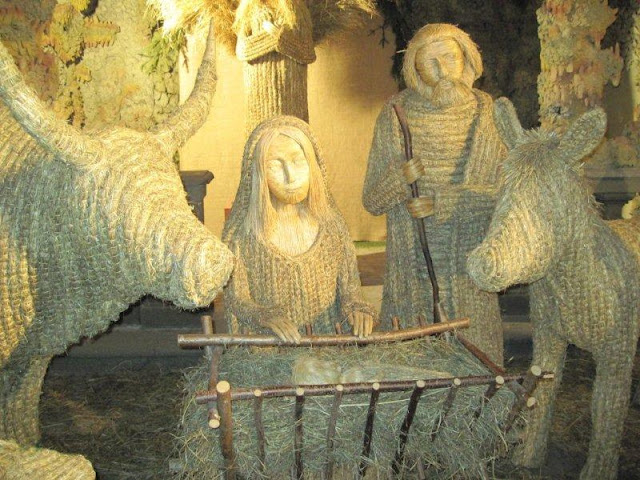It all happened a long time ago probably in the 1980’s. When my daughter was about 12 years old she wanted her bedroom to have a new, grownup look. We researched various different styles, added some new furniture and found the perfect picture for the wall. It was a print called “The Four Seasons” by Alphonse Mucha. I knew practically nothing about him, other than I wasn’t sure how to pronounce his name and that he was born somewhere in Europe.
Over the years I had a love affair with that print which inspired me do some research. I discovered Mucha did a lot of posters for Sarah Bernhardt and was considered Art Nouveau. I had seen Mucha calendars in bookstores and sometimes saw his posters being used in advertising various products. I felt I was becoming addicted to Mucha!
Now we move forward to December, 2008. Our first trip to Prague. Before travelling there I browsed the internet to learn more about the city and what it had to offer. Imagine my delight to find out there was a Mucha Museum in Prague. I told Michael it was definitely on the list to go and see!
Once in Prague, we located the museum on a map, figured out what Metro to take and off we went (see link at the bottom of this posting for instructions and map).
I learned so much about Mucha through the exhibits in the museum. He was born in Southern Moravia (Czechoslovakia) in 1860. As a young man, Mucha spent a great deal of time in Paris (1887 – 1904) where he did art work for Sarah Bernhardt. Many examples of his art work was on display. Of course seeing the first Four Seasons (which was a little different from the one that my daughter had in her room), was a highlight. Also on exhibit were several decorative panels which showed his conception of Art Nouveau. I believe Mucha would be considered the Father of Art Nouveau.
Pages from his Parisian sketchbooks, never exhibited before, can also be seen. Examples of decorated books are found in the show cases. The work he created consists of posters, drawings and oil paintings. At the end of the exhibition I saw what Mucha’s studio in Paris must have looked like, with some of the original furniture, photos of his family and a set of photographs taken in the studio. A half hour long documentary film about the life and work of the artist is also a part of the exhibition, which really answered many of my questions. I found it interesting that his family still runs the Museum.
Here is a site that shows some examples of his art work: http://arthistory.about.com/od/from_exhibitions/ig/mucha_belvedere/
After many repeated invitations to visit the United States, Mucha finally accepted an invitation and went to the United States in 1904. For a time he was the guest of President Theodore Roosevelt and his family. While there, Mucha made portraits of some of the most important American families and also of well-known actresses, like Ethel Barrymore, Maude Adams, and others. He also had exhibits in New York and Chicago. In addition to Mucha’s many works of art, he was asked by the government to organize art education in the United States. He assisted in this and also taught art classes to hundreds of students.
Between 1904 and 1913 Mucha visited America six times, hoping to accumulate enough capital to begin work on his painting of the (now famous) Slav epic and to insure the future of his family.
According to Wikipedia: “When German troops marched into Czechoslovakia in the spring of 1939, Mucha was among the first persons to be arrested by the Gestapo. During the course of his interrogation, the aging artist fell ill with pneumonia. Though eventually released, he never recovered from the strain of this event, or from seeing his homeland invaded and overcome. He died in Prague on 14 July 1939, of a lung infection, and was interred in the Vysehrad cemetery.” Michael and I visited this famous cemetery, but the snow kept me from finding all the gravesites I wanted to see. As a note of interest, Vysehrad cemetery is full of famous people: musicians, artists, poets, writers and, as I understand it, NO politicians!
This photo is of a later visit. Mucha’s plague is located on the lower left of this central monument or “common” grave.
So, what started out as a poster on my daughter’s bedroom wall in Portland, Oregon, USA has taken me down many paths ending up in the Mucha Museum in Prague, the Czech Republic!
But the Mucha journey has not fully ended yet. There is the Slav Epic yet to see. It has been in the news most of this last year, becoming a very heated and controversial issue of which I have dutifully followed. Read all about it in my next posting!
NOTE: Address and directions to the Mucha Museum – http://www.pragueexperience.com/places.asp?PlaceID=614
Mucha, museum, Four Seasons, Vysehrad cemetery, Prague







 We went during the Christmas holidays so they were exhibiting many different Nativity Scenes over the ages. This one was life size and made from straw. Others were of wood and one was entirely made from wax!
We went during the Christmas holidays so they were exhibiting many different Nativity Scenes over the ages. This one was life size and made from straw. Others were of wood and one was entirely made from wax!